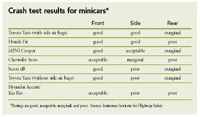Article
Update
Author(s):
Professional and financial news you can use.
TRANSPARENCY
Doctors say this ratings system clouds the issue

YOUNG DOCTORS
Financial burdens get heavier
On average, graduating allopathic medical students owed 8.5 percent more last year than their counterparts in 2005, according to the Association of American Medical Colleges. New doctors who attended public colleges owed a median $120,000 including premed borrowing, while those in private colleges racked up educational debts of $160,000. Overall in 2006, nearly 87 percent of graduates had incurred educational debts, with 14 percent owing $200,000 or more.
QUALITY
Safety concerns may color patients' perception
Patients define "medical error" more broadly than clinicians, and it's important that physicians recognize these differences, according to a study published in the January issue of the Joint Commission Journal on Quality and Patient Safety. For example, clear communication and provider responsiveness are particularly important for patients. If these are missing, says lead author Thomas E. Burroughs, patients are more likely to perceive that an error has occurred when it hasn't. In addition, a strong link exists between patients' concerns about medical safety and their satisfaction with the entire hospital experience. The study found that certain groups-middle-aged patients, African-Americans, and parents of pediatric patients-were more likely to worry about medical errors, as were patients who experienced longer lengths of stay, more-severe illnesses, and those admitted through the ED. On the other hand, patients treated in small and rural hospitals reported the fewest concerns, regardless of the severity of their illness.
CARS
Minicars are short on safety

Speaking of fuel economy, 2008 model cars will sport new stickers that better predict their actual gasoline use, says the US Environmental Protection Agency. The EPA is changing how it estimates fuel economy to take into account real-life factors, such as high-speed driving, aggressive accelerations, air conditioning, and driving in cold temperatures.





